-
Paper Information
- Paper Submission
-
Journal Information
- About This Journal
- Editorial Board
- Current Issue
- Archive
- Author Guidelines
- Contact Us
American Journal of Mathematics and Statistics
p-ISSN: 2162-948X e-ISSN: 2162-8475
2019; 9(4): 165-176
doi:10.5923/j.ajms.20190904.03

Natural Convection of Double-Diffusive Flow of Heat Generating Fluid in a Vertical Channel
Benjamin Boniface1, Abiodun O. Ajibade2
1Department of Mathematics, Aduvie Pre-University, Jahi District Abuja, Nigeria
2Department of Mathematics, Ahmadu Bello University, Zaria, Nigeria
Correspondence to: Benjamin Boniface, Department of Mathematics, Aduvie Pre-University, Jahi District Abuja, Nigeria.
| Email: |  |
Copyright © 2019 The Author(s). Published by Scientific & Academic Publishing.
This work is licensed under the Creative Commons Attribution International License (CC BY).
http://creativecommons.org/licenses/by/4.0/

Natural convection double diffusive flow heat generating fluid in a vertical channel has been examined. Diffusion-thermo (Dufour) and heat generating effects are also considered. Suitable transformations are employed to convert the partial differential equations representing the concentration, temperature and velocity into a system of ordinary differential equations. Approximate solutions are obtained for velocity, skin-friction, temperature, heat transfer, concentration and mass transfer by the use of a two-term harmonic and non-harmonic perturbation method. The result for the mixture of carbon dioxide  in air
in air  are presented graphically. It is found that the velocity decreases with increasing slip
are presented graphically. It is found that the velocity decreases with increasing slip  while it increases with increasing thermal diffusion
while it increases with increasing thermal diffusion  Also the mean skin-friction |M| and the phase of the rate of heat transfer |N| increases with increase in the buoyancy parameter as well as Dufour effect while both the temperature and concentration increase near the hot plate and decreases exponentially towards the cold plate.
Also the mean skin-friction |M| and the phase of the rate of heat transfer |N| increases with increase in the buoyancy parameter as well as Dufour effect while both the temperature and concentration increase near the hot plate and decreases exponentially towards the cold plate.
Keywords: Natural convection, Double-diffusive, Heat generating and Dufour effect
Cite this paper: Benjamin Boniface, Abiodun O. Ajibade, Natural Convection of Double-Diffusive Flow of Heat Generating Fluid in a Vertical Channel, American Journal of Mathematics and Statistics, Vol. 9 No. 4, 2019, pp. 165-176. doi: 10.5923/j.ajms.20190904.03.
Article Outline
1. Introduction
- Double-diffusive convection flows are generated by buoyancy effect caused by combined temperature and concentration gradients. It finds its application in oceanography process, multi-component convection flows induced by density gradient and some technological applications.In literature, the wide range applications of double-diffusive convection is well reported in [1-5], Boutana et al [6], reported that for multiple solutions, the variety of buoyancy ratios is dependent on the kind of convection generated by the solute gradients. Similarly, Nithyaderi and Yang [7] investigated double-diffusive natural convection in a partial heated enclosure with soret and Dufour effects. Jha et al [8] examined the role of thermal diffusive on double-diffusive natural convection in a vertical annular porous medium.On the other hand, several investigations have been made on natural convective heat transfer to viscous incompressible slip flow past a channel. This is due to useful applications in electric cooling, heat exchangers and physiological type flows and so on. Jha et al [9] studied free convection flow of heat generating absorbing fluid between vertical porous plate with periodic heat input. Under soret and dufour effect, Hayat. et al [10] studied Melting heat transfer in a boundary layer flow while Jha and Ajibade [11], studied free convection flow between Heat and Mass Transfer Flow in a vertical Channel with Dufour effect. Similarly, Ajibade [12], examined Dual-phase-lag and dufour effects on unsteady double-diffusive convection flow in a vertical micro-channel filled with porous material, Also, the influence of periodic temperature and concentration on free convection, flow and heat transfer past a vertical plate in slip-flow region was presented by Sharma [13]. Srinivasa and Eswara, [14] studied unsteady free convection flow and heat transfer from an isothermal truncated cone with variable viscosity. Hossain et al [15] surveyed the influence of fluctuating surface temperature and concentration on natural convection flow from a vertical flat plate. Moreover, Sharma and Chaudhary [16] examined the effect of variable suction on transient free convective viscous incompressible flow past a vertical plate with periodic temperature variations in slip-flow regime, While Anwar [17] investigated MHD unsteady free convective flow past a vertical porous plate. Also, Soundalgekar and Wavre [18,19] presented the unsteady free convection and mass transfer flow past an infinite vertical plate with constant and variable suction, while, Chen et al [20] investigated ,the combined heat and mass transfer in mixed convective flow along an inclined plate. More details on velocity slip and temperature jump are found in Haddad et al [21,22]. Similarly, heat generating and heat transfer was studied by the following people. Ogulata and Dabo [23] investigated Experiment and entropy generation minimization analysis of a cross flow heat exchanger. Flow and heat transfer characteristics of transverse perforated rids under impingement was studied by Caliskan [24], while Heat/mass transport in a drop translating in time-periodic electric field was found by Abdelaal and Jog [25]. Zambra and Moraga [26], Examined Heat and mass transfer in landfills simulation of the pile self-heating and of soil contamination. Conjugate heat transfer in a plate –one surface at constant temperature and the other cooled by forced or natural convection was studied by Matti and Reijo [27]. Hadi and Jerzy [28], investigated Maximization of heat transfer across micro-channels. Mohamed and Tassos [29], studied Heat transfer correlation for flow boiling in small to micro tube. Alessandra and Augusta [30], investigated Mass/heat transfer through laminar boundary layer in ax symmetric micro channels with non uniform cross section and fixed wall concentration/temperature. Heat transfer mechanism in pool boiling and solidification is found in Heui-seol [31,32]. In the work Sharma [13], there is velocity slip on the boundary plate. However, due to partial contact between the plate and fluid particles which is caused by the slip, it is expected that there is temperature as well as concentration jumps on the boundary as well. This fact was not addressed in [13], which motivate the authors to conduct the present research.The objective of the present investigation is to study Natural convection double-diffusive flow of heat generating fluid in a vertical channel, considering the velocity slip, as well as boundary jump in temperature and concentration.
2. Formulation of the Problem
- Double-diffusive free convective flow of heat generating fluid in a vertical channel is considered.The x*- axis is taken in vertical upward direction along the vertical porous plate and y* – axis is taken normal to the plate. The plates are considered infinite in the x*- direction so that all physical quantities are dependent on y* and t* only. In the present problem, the fluid temperature is governed by mass flux, hence the Dufour effect is considered in the energy equation. Neglecting viscous dissipation and then assuming variation of density in the body force term (Boussinesq’s approximation) the problem is governed by the following set of equations.
 | (1) |
 | (2) |
 | (3) |
 | (4) |
 direction,
direction,  vanishes so that continuity equation reduces to
vanishes so that continuity equation reduces to | (5) |
 to be function of
to be function of  only. Following [2], we take
only. Following [2], we take  . Where
. Where  and
and  are constants.The boundary conditions for the present problem, considering the velocity slip, boundary jump and steady-periodic heat and concentration input on the boundary are
are constants.The boundary conditions for the present problem, considering the velocity slip, boundary jump and steady-periodic heat and concentration input on the boundary are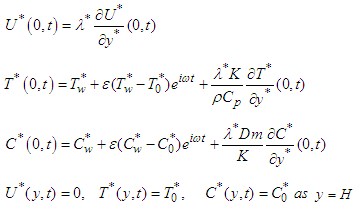 | (6) |
 | (7) |
 is the Grashof number,
is the Grashof number,  is the modified Grashof number,
is the modified Grashof number,  is the Prandtl number,
is the Prandtl number,  is the Schmidt number,
is the Schmidt number,  is heat generating parameter and
is heat generating parameter and  is jump/ slip parameter. All the physical parameters used are defined in the nomenclature.Upon substitution of equation (7) into the governing equation (1)-(3) and the boundary condition (6), the equations are presented in dimensionless form as
is jump/ slip parameter. All the physical parameters used are defined in the nomenclature.Upon substitution of equation (7) into the governing equation (1)-(3) and the boundary condition (6), the equations are presented in dimensionless form as  | (8) |
 | (9) |
 | (10) |
 | (11) |
3. Solution of the Problem
- Assuming small amplitude oscillations
 , we can represent the velocity U, temperature
, we can represent the velocity U, temperature  , and concentration near the plate.To obtain the solutions for the velocity, concentration and energy equations (8)-(10), we separate the variables into the harmonic and non-harmonic parts as follows
, and concentration near the plate.To obtain the solutions for the velocity, concentration and energy equations (8)-(10), we separate the variables into the harmonic and non-harmonic parts as follows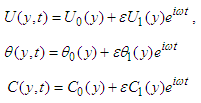 | (12) |
 , we have the following set of ordinary differential equations
, we have the following set of ordinary differential equations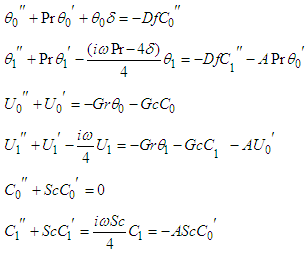 | (13) |
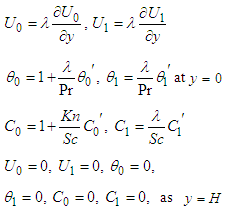 | (14) |
 | (15) |
 | (16) |
 | (17) |
 | (18) |
 | (19) |
 | (20) |
 | (21) |
 | (22) |
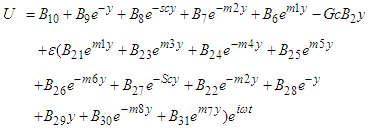 | (23) |
 | (24) |
 | (25) |
 Where the Amplitude is
Where the Amplitude is  and the Phase of the Skin-friction is
and the Phase of the Skin-friction is 
 and the mean skin-friction
and the mean skin-friction  is denoted
is denoted Heat Transfer: Knowing that in dynamics of viscous fluid the interest is not much in knowing all the details of the velocity and temperature fields but would therefore like to know quantity of heat exchange between the body and the fluid. Now, at the boundary, the heat exchanged between the fluid and the body is only due to conduction, accordingly, using the Fourier’s law, the heart transfers in governed by the equation.
Heat Transfer: Knowing that in dynamics of viscous fluid the interest is not much in knowing all the details of the velocity and temperature fields but would therefore like to know quantity of heat exchange between the body and the fluid. Now, at the boundary, the heat exchanged between the fluid and the body is only due to conduction, accordingly, using the Fourier’s law, the heart transfers in governed by the equation. | (26) |
 | (27) |
 . Where Amplitude is
. Where Amplitude is  and The phase, the rate of heat transfer is
and The phase, the rate of heat transfer is  Where,
Where, 
4. Discussion
- The effect of thermal diffusion in natural convection flows is very important in many applications. The formulations may be examined to indicate the nature of the interaction of the various contributing terms to buoyancy. For the purpose of this analysis our discussion will be restricted to the aiding or favorable case only. Then, for fluid with Prandtl number
 which represent air at 20°C at 1 atmosphere. Chosen the value of the Schmidt number,
which represent air at 20°C at 1 atmosphere. Chosen the value of the Schmidt number,  to represent the presence of species Carbon dioxide in air
to represent the presence of species Carbon dioxide in air  Then, the values of
Then, the values of  and
and  are selected arbitrarily. We take
are selected arbitrarily. We take  that correspond to the cooling of the plate by free convection currents. It is also important to note that negative value of
that correspond to the cooling of the plate by free convection currents. It is also important to note that negative value of  leads to suction through the porous boundary plate while positive values depict injection through the heated plate y=0. The velocity profiles for the binary mixture of air and carbon dioxide are presented in figs 1-4. Now, it is observed from the figures that the velocity increases rapidly near the heated plate, attains a maximum value and then decreases exponentially toward the cold plate. Also, figure 1 show that increasing
leads to suction through the porous boundary plate while positive values depict injection through the heated plate y=0. The velocity profiles for the binary mixture of air and carbon dioxide are presented in figs 1-4. Now, it is observed from the figures that the velocity increases rapidly near the heated plate, attains a maximum value and then decreases exponentially toward the cold plate. Also, figure 1 show that increasing  lead to decrease in the velocity, at same time increase
lead to decrease in the velocity, at same time increase  leads to little increase in the velocity and increasing
leads to little increase in the velocity and increasing  , also leads to more increase in the same velocity. We may said that increase in
, also leads to more increase in the same velocity. We may said that increase in  or
or  leads to corresponding increase in velocity. This is physically true since growing
leads to corresponding increase in velocity. This is physically true since growing  or
or  enhances the buoyancy of the fluid and strengthens the convection currents which eventually increase the velocity. The figure further shows that an increase in
enhances the buoyancy of the fluid and strengthens the convection currents which eventually increase the velocity. The figure further shows that an increase in  increases the slip velocity on the porous plate while the velocity of the fluid decreases. The effect of the Dufour parameter on the hydrodynamics is the subject of figure 2. The figure shows that an increase in velocity is achieved by growing the Dufour parameter. The figure further reveals that the effect of velocity slip on the wall could be controlled by varying the buoyancy parameters
increases the slip velocity on the porous plate while the velocity of the fluid decreases. The effect of the Dufour parameter on the hydrodynamics is the subject of figure 2. The figure shows that an increase in velocity is achieved by growing the Dufour parameter. The figure further reveals that the effect of velocity slip on the wall could be controlled by varying the buoyancy parameters  and
and  since increase in
since increase in  and/or
and/or  also acts to support and increase the boundary slip on the surface of the porous plate. The effect of the suction /injection parameter
also acts to support and increase the boundary slip on the surface of the porous plate. The effect of the suction /injection parameter  on the hydrodynamics in shown in figure 3. The figure shows that the velocity remain constant with the increase of suction parameter
on the hydrodynamics in shown in figure 3. The figure shows that the velocity remain constant with the increase of suction parameter . From figure 1 and 3, it could be observed that the slip velocity increases near the boundary plate as
. From figure 1 and 3, it could be observed that the slip velocity increases near the boundary plate as  increases. However, due to rare faction of the fluid, the velocity of fluid away from the boundary surface decreases with growing
increases. However, due to rare faction of the fluid, the velocity of fluid away from the boundary surface decreases with growing  . It was also observed that fixed values of
. It was also observed that fixed values of  and
and  the velocity of the binary mixture of carbon dioxide in air increases with growing
the velocity of the binary mixture of carbon dioxide in air increases with growing  due to cooling of the plate by free convection currents. In figure 4, it is observed that fluid velocity induced by constant heat and solute inputs on the boundary (
due to cooling of the plate by free convection currents. In figure 4, it is observed that fluid velocity induced by constant heat and solute inputs on the boundary ( ) is higher, while it decreases as the oscillation sets in at the thermal as well as concentration boundary condition (
) is higher, while it decreases as the oscillation sets in at the thermal as well as concentration boundary condition ( ).
).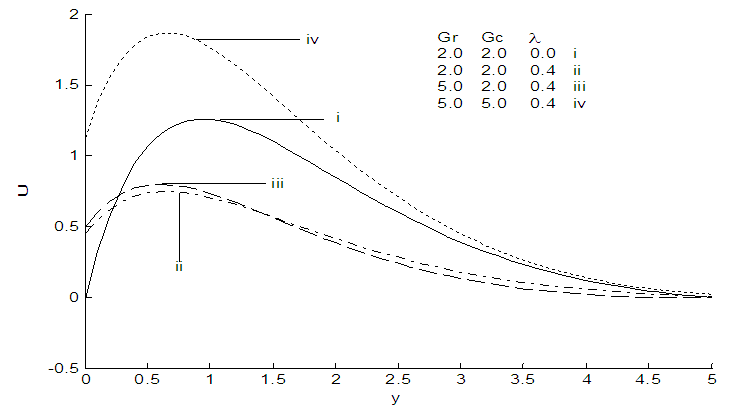 | Figure 1. Velocity profiles of carbon dioxide (Sc=0.94) in air (Pr=0.71), for different values of  and and  ωt =0.2, A=5, and ε=0.02 ωt =0.2, A=5, and ε=0.02 |
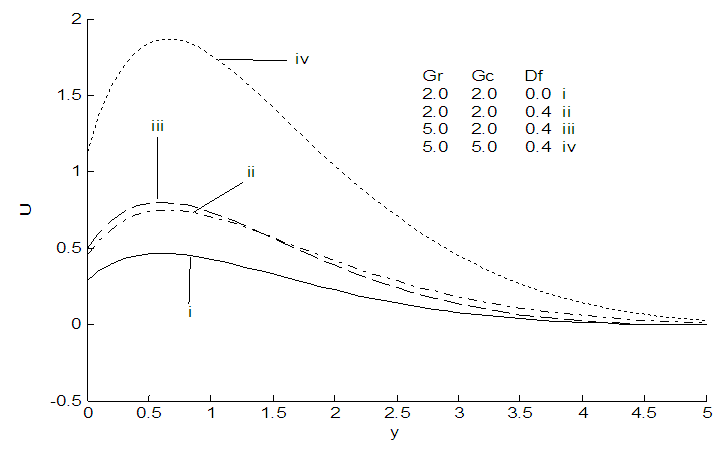 | Figure 2. Velocity profiles of carbon dioxide (Sc = 0.94) in air (Pr = 0.71)  = 10, and = 10, and  = 0.02 for different values of = 0.02 for different values of  and and  |
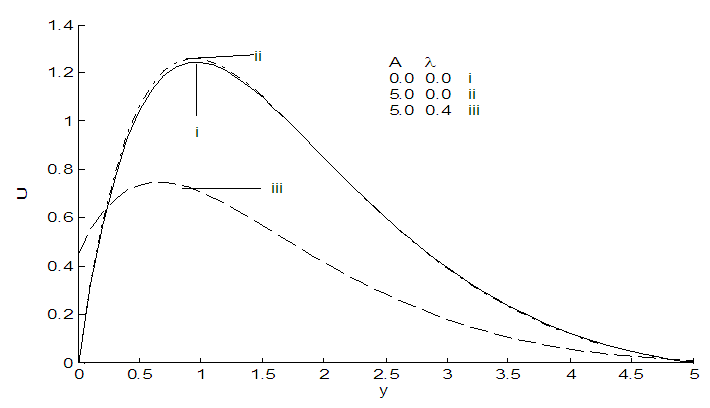 | Figure 3. Velocity profiles of carbon dioxide (Sc=0.94) in air (Pr=0.71) for  ωt=0.2, ω=10, and ε=0.02 ωt=0.2, ω=10, and ε=0.02 |
 | Figure 4. Velocity profiles of carbon dioxide (Sc=0.94) in air (Pr=0.71) for  |
 and this is caused by the increase in the molecular distance of the fluid particles which acts against thermal diffusion within the fluid. The figure further shows that fluid temperature decreases as the Dufour number increases. The mean skin-friction of carbon dioxide for air is shown in Fig.6. It is observed from this figure that the mean skin-friction decreases with increasing Dufour parameter. Also, the mean skin-friction increase due to the increase in
and this is caused by the increase in the molecular distance of the fluid particles which acts against thermal diffusion within the fluid. The figure further shows that fluid temperature decreases as the Dufour number increases. The mean skin-friction of carbon dioxide for air is shown in Fig.6. It is observed from this figure that the mean skin-friction decreases with increasing Dufour parameter. Also, the mean skin-friction increase due to the increase in  or
or  or both. Furthermore, it may be concluded that the mean skin-friction increases with more cooling of the plate by free convection currents.
or both. Furthermore, it may be concluded that the mean skin-friction increases with more cooling of the plate by free convection currents.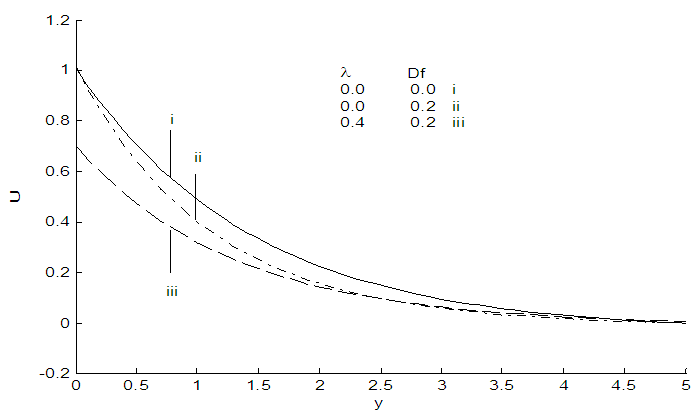 | Figure 5. Temperature profiles of carbon dioxide (Sc=0.94) in air (Pr=0.71) for  |
 | Figure 6. The mean skin-friction of carbon dioxide (Sc=0.94) for (air) Pr=0.71 |
 of the skin-friction for CO2 in air is shown in Fig.7. It is evident from this figure that amplitude increases with decreasing
of the skin-friction for CO2 in air is shown in Fig.7. It is evident from this figure that amplitude increases with decreasing  while an increase in
while an increase in  or
or  leads to an increase in amplitude of skin-friction on the boundary plate. The effect of
leads to an increase in amplitude of skin-friction on the boundary plate. The effect of  on the amplitude of skin-friction shows an increase in the amplitude as
on the amplitude of skin-friction shows an increase in the amplitude as  increases. However, as
increases. However, as  increases the effect of
increases the effect of  on the amplitude of the skin-friction becomes negligible.
on the amplitude of the skin-friction becomes negligible. | Figure 7. The amplitude of skin-friction of carbon dioxide (Sc=0.94) in air (Pr=0.71) for ω=10 |
 (injection parameter) while decreases with the increase of frequency of periodic heating
(injection parameter) while decreases with the increase of frequency of periodic heating  . This figure shows that the values of temperature are greater in vicinity of the heated plate and decreases exponentially toward the cold plate.
. This figure shows that the values of temperature are greater in vicinity of the heated plate and decreases exponentially toward the cold plate.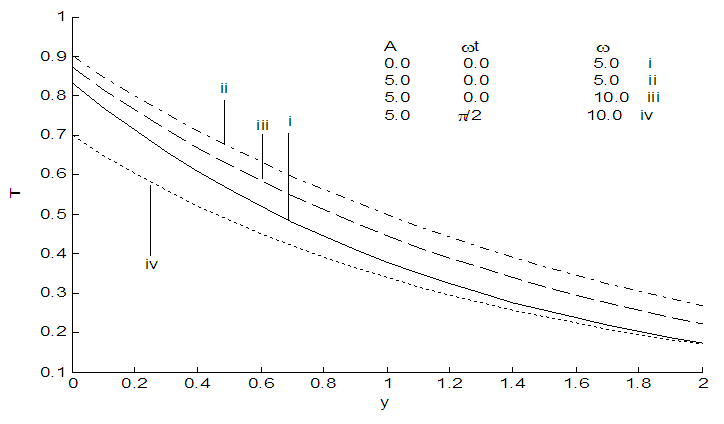 | Figure 8. The temperature profiles for (air) Pr = 0.71 and  |
 and suction parameter
and suction parameter  . The concentration decreases with increasing
. The concentration decreases with increasing  (suction parameter). It is also evident that the concentration decreases with increasing
(suction parameter). It is also evident that the concentration decreases with increasing  (rarefaction parameter) It is discovered that concentration decreases exponentially towards the cold plate.
(rarefaction parameter) It is discovered that concentration decreases exponentially towards the cold plate. | Figure 9. The concentration profile of carbon dioxide (Sc = 0.94) for  |
 or
or  leads to corresponding increase in velocity. Because, it is physically true since growing
leads to corresponding increase in velocity. Because, it is physically true since growing  or
or  enhances the buoyancy of the fluid and strengthens the convection currents which eventually increase the velocity. The figure further reveals that an increase in the heat generating parameter
enhances the buoyancy of the fluid and strengthens the convection currents which eventually increase the velocity. The figure further reveals that an increase in the heat generating parameter  increases the velocity within the channels. This physical fact is attributed to the heat generation which grows the fluid temperature and hence strengthen the convection current which act to increase the fluid velocity.
increases the velocity within the channels. This physical fact is attributed to the heat generation which grows the fluid temperature and hence strengthen the convection current which act to increase the fluid velocity.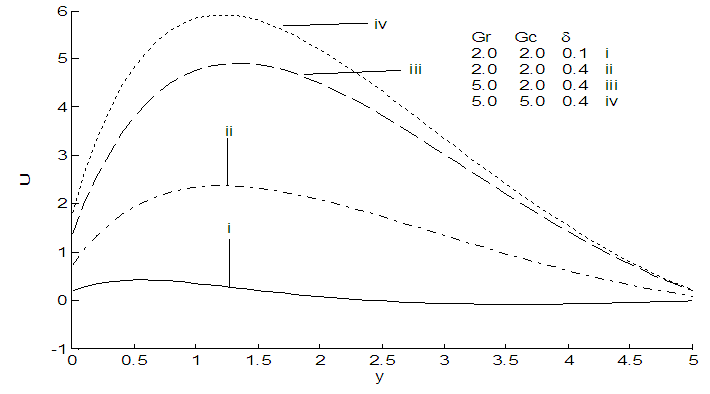 | Figure 10. The velocity profiles of carbon dioxide (Sc=0.94) in air (Pr=0.71) for  |
 , this also reveals that increasing
, this also reveals that increasing  and
and  leads to increase in the phase of the skin-friction while reverse effect is observed for
leads to increase in the phase of the skin-friction while reverse effect is observed for  , hence, the phase of skin-friction decreases with the increase of
, hence, the phase of skin-friction decreases with the increase of  . The amplitude
. The amplitude  and phase
and phase  of rate of heat transfer are presented in table 2. This table shows that the amplitude of rate of heat transfer
of rate of heat transfer are presented in table 2. This table shows that the amplitude of rate of heat transfer  increases with growing injection parameter while it increases when increasing frequency
increases with growing injection parameter while it increases when increasing frequency  on the other hand, the phase of rate of heat transfer
on the other hand, the phase of rate of heat transfer  decreases with increase in the injection through the heated plate parameter while it increases as
decreases with increase in the injection through the heated plate parameter while it increases as  increases.
increases.
|
|
5. Conclusions
- The effect of Dufour on Natural convection double-diffusive flow of heat generating fluid in a vertical channel was examined. Three partial differential equations were used representing velocity temperature and concentration. While, perturbation method was used to solve the equations. During the course of investigation, it is found that as
 increases the velocity slip increases on the boundary plate while the fluid velocity decreases within the channel. Also, the velocity increases with increasing
increases the velocity slip increases on the boundary plate while the fluid velocity decreases within the channel. Also, the velocity increases with increasing 
 and
and  In addition, the mean skin-friction
In addition, the mean skin-friction  , amplitude and the phase of the rate of heat transfer
, amplitude and the phase of the rate of heat transfer  increases with increases in
increases with increases in  and
and  while increases
while increases  and
and  leads to decreases in it. The temperature and concentration both are increases near the hot plate and decreases exponentially far away from the cold plate.
leads to decreases in it. The temperature and concentration both are increases near the hot plate and decreases exponentially far away from the cold plate.Nomenclature and Greek Letters
- Nomenclature
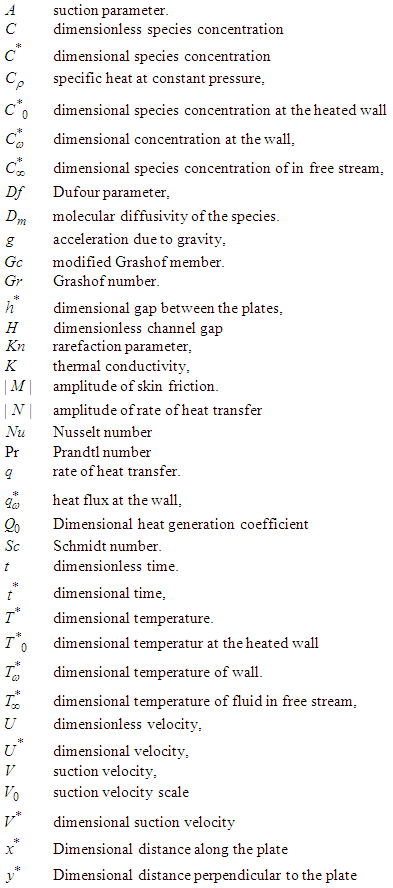 Greek letters
Greek letters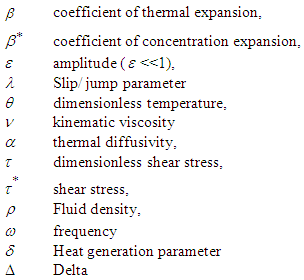
Appendix



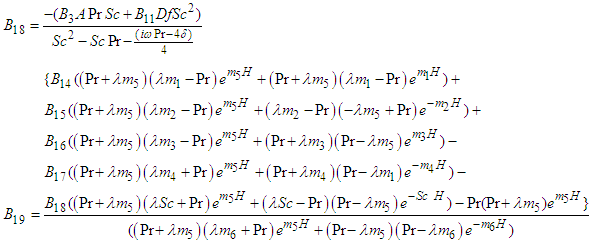

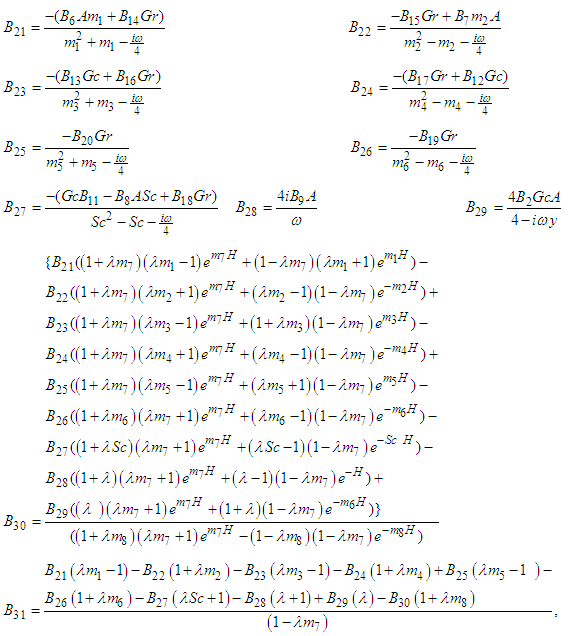
 Abstract
Abstract Reference
Reference Full-Text PDF
Full-Text PDF Full-text HTML
Full-text HTML for carbon dioxide
for carbon dioxide  and
and 

